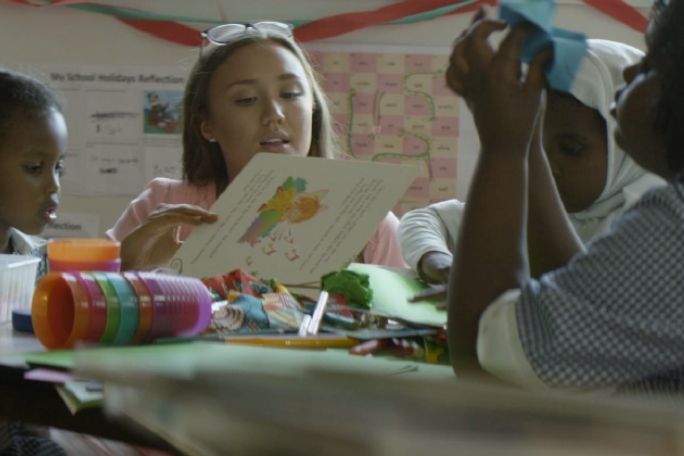Lesson summary
This lesson is part of the Aspire Generation English Unit. Students examine descriptive and sensory writing as a communication technique that engages audiences with different aspects of a local community issue. They decide on an issue and consider the ways that aspects of this issue (such as impact, cause, effect, possible solutions, people affected) can be emphasised using descriptive and sensory language. They practise this language and style of writing using the five senses (touch, taste, sight, sound, smell) with an emphasis placed on self and peer editing for grammatical accuracy. They conclude the lesson by analysing and reflecting on the effectiveness of descriptive and sensory writing in the context of local community
Learning intentions:
Students will...
- understand how effective descriptive and sensory writing can be used to both inform and influence audiences
- enhance their descriptive and sensory writing and editing skills.
Lesson guides and printables
Lesson details
Curriculum mapping
Australian curriculum content descriptions:
Year 9 English:
- Create imaginative, informative and persuasive texts that present a point of view and advance or illustrate arguments, including texts that integrate visual, print and/or audio features (ACELY1746)
- Review and edit students’ own and others’ texts to improve clarity and control over content, organisation, paragraphing, sentence structure, vocabulary and audio/visual features (ACELY1747)
Year 10 English:
- Create sustained texts, including texts that combine specific digital or media content, for imaginative, informative, or persuasive purposes that reflect upon challenging and complex issues (ACELY1756)
- Review, edit and refine students’ own and others’ texts for control of content, organisation, sentence structure, vocabulary, and/or visual features to achieve particular purposes and effects (ACELY1757)
General capabilities: Literacy, Personal and Social Capability, Critical and Creative Thinking, ICT Capability
Cross-curriculum priorities: There are opportunities for students to engage with any of the cross-curriculum priorities across the scope of this unit. Direct or specific engagement with any of these can be made based on the unique attributes of the local community. Sustainability, Asia and Australia’s Engagement with Asia, Aboriginal and Torres Strait Islander Histories and Cultures
Relevant parts of Australian Curriculum English Achievement Standards:
Year 9: By the end of Year 9, students analyse the ways that text structures can be manipulated for effect. They analyse and explain how images, vocabulary choices and language features distinguish the work of individual authors. They evaluate and integrate ideas and information from texts to form their own interpretations. They select evidence from texts to analyse and explain how language choices and conventions are used to influence an audience. Students understand how to use a variety of language features to create different levels of meaning. They understand how interpretations can vary by comparing their responses to texts to the responses of others. In creating texts, students demonstrate how manipulating language features and images can create innovative texts. Students create texts that respond to issues, interpreting and integrating ideas from other texts. They edit for effect, selecting vocabulary and grammar that contribute to the precision and persuasiveness of texts and using accurate spelling and punctuation.
Year 10: By the end of Year 10, students explain how the choice of language features, images and vocabulary contributes to the development of individual style. They develop and justify their own interpretations of texts. They listen for ways features within texts can be manipulated to achieve particular effects. Students show how the selection of language features can achieve precision and stylistic effect. They develop their own style by experimenting with language features, stylistic devices, text structures and images. Students create a wide range of texts to articulate complex ideas. They demonstrate understanding of grammar, vary vocabulary choices for impact, and accurately use spelling and punctuation when creating and editing texts.
Unit of work: La Trobe University – Aspire Generation – English
Time required: 90 mins.
Level of teacher scaffolding: Medium – facilitate class discussion.
Resources required
- Student Worksheets – one copy per student OR computers/tablets to access the online worksheet
- Device capable of presenting a video to the class. Sensory Writing Slide, Sensory Writing Example: “Dying Steppe”
- Descriptive and Sensory Writing Factsheet
- Editing Checklist
Skills
This lesson is designed to build students’ competencies in the following skills:
- Collaboration
- Communication
- Community Engagement
- Creativity
- Digital Literacy
- Empathy
- Social Skills
Additional info
This lesson supports La Trobe University’s Aspire Generation initiative, which empowers students to drive change through community engagement, volunteerism and leadership opportunities.


Welcome back!
Don't have an account yet?
Log in with:
By signing up to Cool.org you consent and agree to Cool's privacy policy to
store, manage and process your personal information. To read more, please see
our privacy policy here(Opens in new tab).
Create your free Cool.org account.
Many of our resources are free, with an option to upgrade to Cool+ for premium content.
Already have an account?
Sign up with:
By signing up to Cool.org you consent and agree to Cool's privacy policy to
store, manage and process your personal information. To read more, please see
our privacy policy here(Opens in new tab).